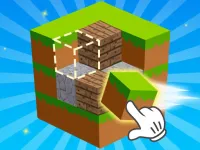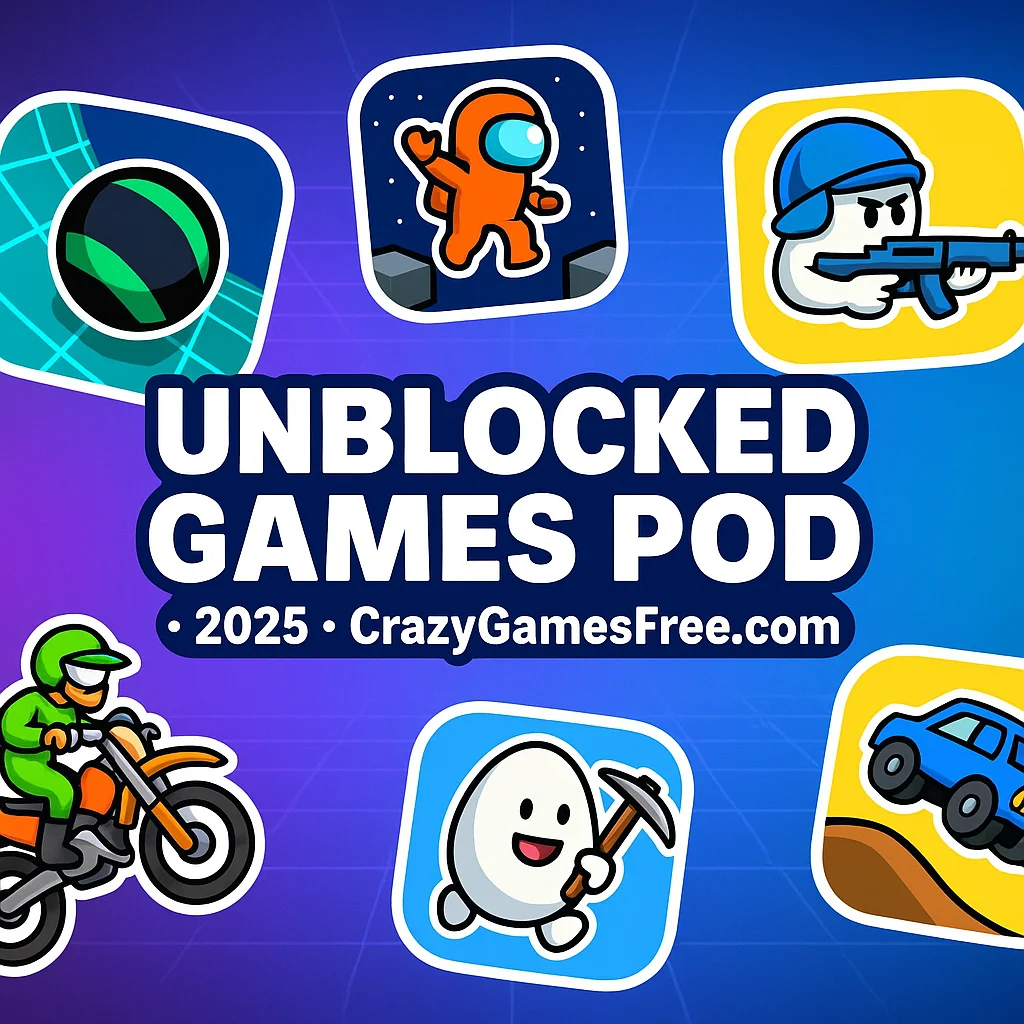
Minecraft Unblocked Online

Girl Games Unblocked: Mini Fun

Fall Guys Unblocked Web Multiplayer

Tralalero Tralala Endless Run

Sky Bus Mega Ramp Drive

Arrow Survival: 15 Seconds

Wednesday Addams Beauty Salon

Bid Wars 1 Auction Simulator

Mineblocks

Police Chase 2

My Arcade Center

Hungry Shark Evolution 2

Koko Loco Block Blast

Draw a skin for Mineblock with physics

Jungle Fury Mutant Rhino Mayhem

If you strip away the hype, an unblocked games pod is a tight, portable hub where players can jump into browser titles from school, work, or locked-down networks without tripping filters. Think of it as a small curated capsule of games that load fast, run in the browser, and avoid heavy installs or sketchy popups. The goal is simple: hit play quickly, avoid drama, and keep your focus on the game loop rather than on battling the network.
Random link dumps age fast and break often. A pod, when done right, acts like a focused library with rules. It prioritizes HTML5 over legacy tech, trims bloated assets, and standardizes UI. You get fast first input delay, predictable controls, and consistent onboarding. The pod approach also makes content governance easier. You can switch out retired titles, replace heavy assets, and maintain a consistent meta across the collection.
At the base level you want three things working together: clean hosting, compression that respects image clarity, and proper caching headers. Minified JS and CSS reduce payload. Sprite sheets or modern image formats reduce layout shifts. Smart input handling keeps controls responsive even on school laptops that are not exactly gaming rigs. None of this is rocket science, but the combo matters when your goal is to be playable anywhere.
Skill games with short loops are S tier in pods because they deliver fun without long load times. Puzzle micro loops, physics tossers, lane runners, minimalist racers, and aim trainers all shine. Light multiplayer that tolerates high latency can work as long as rounds are short and matchmaking is simple. Avoid content that demands large textures or heavy shaders. Keep the footprint lean and the fun loop instant.
The pod concept lives inside the broader world of browser gaming. If someone asks you what these games are in a textbook sense, they are browser titles that run without local installs and that can be shared by a link. For a straight definition of the medium itself, see browser game. You do not need to be a developer to use a pod, but understanding that you are running games directly in the browser helps explain why load order, asset weight, and compatibility matter.
No one is rocking a 4090 in homeroom. Pods that work well put time into input latency and stability rather than ultra effects. If an effect hurts frame time during heavy collision moments, remove it. If a sound loop causes stutter, compress or shorten it. People quit when the inputs feel mushy, not because the bloom looks mid. A good pod favors honest responsiveness over sugar.
There is no magic button. A pod that stays reachable uses clean paths, avoids red-flag third parties, and hosts assets in a sane way. Short domain chains and predictable CDNs reduce block triggers. Minimal external requests cut down on errors and timeouts. And if a single title gets blocked or broken, the pod format lets you rotate it out quickly without bricking the whole hub.
Less is more. Start with a dozen dependable games and maintain them. Track playtime, rage quits, and bounce. Retire slow loaders. Keep a bench of replacements ready. The meta is not about largest library. It is about the fastest route to a clean session that respects the player’s time and the network’s limits.
Worn keyboards and janky touchpads are the norm. Bind movement to WASD and arrows. Offer space, enter, or left click as primary action. Add quick remap if possible. Make button hit boxes generous. Communicate inputs in the first three seconds of play with a compact overlay. Your pod wins when someone can sit down at a random lab PC and be competent in under one minute.
You do not want surprise popups or audio spikes. Keep ads minimal and static where possible. Preload quietly. Ensure the escape flow is predictable. Use safe thumbnails. The point is quick fun that does not embarrass the player. A pod that feels safe keeps its audience. A pod that jumpscares with loud auto-play loses the room instantly.
Players should go from click to control in a handful of seconds. Your pod should avoid long landing pages and let the game take center stage. Use short, punchy blurbs. Lead with the verb. Tell me what I will do in ten words, not why your site exists. The call to action is play. Serve that.
Open the pod on bad Wi-Fi. Pull the Ethernet. Switch browsers. Run low battery mode. Try different display scales. If a game only works in your perfect dev setup, it is not pod material. Collect error reports automatically and make decisions weekly. The pod is a living thing. Treat it like one.
Pods that never rotate feel stale. Set a cadence for swap-ins. Track session length and retry rates. Highlight a “today” pick that is actually new. If a title begins to drag performance, bench it. Your best marketing is a consistent streak of smooth sessions. People return when yesterday felt good.
Here is a live hub to explore and benchmark against your standards. It focuses on quick-loading browser titles and a clean path to play:
Open three random games. Time the click-to-input. Note stutters in the first 30 seconds. Check if the controls match the blurb. Press escape and see what happens. Try again in a different browser. If two out of three titles deliver a clean loop with minimal friction on weak hardware, the pod is doing its job. If not, cut or fix.
Keep canvas sizes smart. Use requestAnimationFrame properly. Avoid heavy timers for simple loops. Preload audio lightly. Prefer sprite reuse. Offer low and high quality toggles. Optimize collision checks. Sanity check assets on 1x and 1.5x DPR screens. Small trims, big wins.
Mute by default with a clear toggle. Make pause obvious. Provide quick restarts. Do not bury controls in menus. Keep UI text short and readable. Support keyboard only play as a baseline. Touch support is a bonus, not a blocker.
Your pod page should make it impossible to get lost. Above the fold, show featured titles and a discrete search. Below, use compact categories. Do not paginate into oblivion. Focus on speed and clarity. Use consistent card sizes. Thumbnails should hint at mechanics, not just vibes.
Write helpful H3s that name the mechanic or the fantasy clearly. Keep descriptions human. Avoid keyword stuffing. People arrive for games, not buzzwords. Title tags should reflect what is playable. Structured data is fine, but speed and honesty will outperform tricks over time.
Do not let third-party scripts balloon your payload. Do not slap auto-playing videos into your hero area. Do not run inconsistent control schemes between similar games. And do not ignore the first 500 ms of input after load. That is when trust is won or lost.
The landscape shifts. Browser updates land. School filters tighten. Keep your pod nimble. Maintain a light codebase and a simple path to update individual entries. Consider a tiny diagnostics overlay in dev mode that logs frame time and input latency. Stay curious and prune often.
Pods are ideal training grounds. Because loops are short and feedback is immediate, players can develop timing, pattern recognition, and reaction reliability quickly. A well-chosen set teaches aiming, rhythm, spatial reasoning, and resource discipline without the baggage of giant downloads. That is value you can feel in the first session.
You do not need global chat to feel connected. Lightweight leaderboards or daily challenges can be enough. Keep it clean and opt in. The pod’s job is to enable short, satisfying sessions that people can share with a simple link.
A great unblocked games pod is not a warehouse. It is a studio loft. Less clutter, more focus, easy light, the tools where you expect them. Build it for real devices, real networks, and real time constraints. Players will feel the difference immediately.
What makes a game “pod worthy”
Short load, clear controls, consistent performance on low-end hardware, and no sketchy third parties. If it fails any of those, it does not make the cut.
Can pods include multiplayer
Yes, but keep sessions short and mechanics tolerant of latency. Lightweight co-op or small arenas work better than massive lobbies.
How do pods stay unblocked
There is no guarantee. Sensible hosting, minimal external calls, and quick rotation of problem titles help maintain access while reducing risk.
Are these games safe for classrooms
If the pod is curated with static ads, safe thumbnails, and predictable audio, yes. Test everything on actual school hardware before rollout.
Why do some games feel laggy on school laptops
Old CPUs, thermal throttling, and limited RAM. Favor simpler shaders, smaller textures, and optimized collision. Input responsiveness beats eye candy.
Do I need an account to play
For most pods, no. The point is click to play. Accounts should be optional and only for features that genuinely add value.
How many games should a pod launch with
Start with 10 to 15 reliable titles. Grow slowly. Quality beats quantity when time and bandwidth are tight.
What browsers should a pod support
Target Chromium-based and Firefox on desktop first. Safari compatibility helps, but prioritize what your audience actually uses in labs.
How often should a pod rotate titles
Monthly is a healthy baseline. Bump the cadence if performance dips, or if a title spikes in error reports.
Can pods include mobile-friendly games
Absolutely. Touch support is a bonus. Just do not compromise desktop keyboard clarity to chase mobile UX.
What metrics matter most
Click-to-input time, crash rate, input latency under load, and session length. Track, adjust, repeat.
How do you handle sound in class
Mute by default. Clear on-screen toggle. Subtle audio cues over loud tracks. Respect the environment first.
What is the best way to describe a game card
Use the verb first. Tell the player what they will do. Keep it under 20 words. No filler.
Should a pod have achievements
Only if they add replay value without bloat. Lightweight badges and daily streaks are fine. Avoid heavy profile systems.
Can teachers curate pods
Yes. Provide a simple shortlist tool and a safe-mode view. Keep the controls obvious and the labels plain.